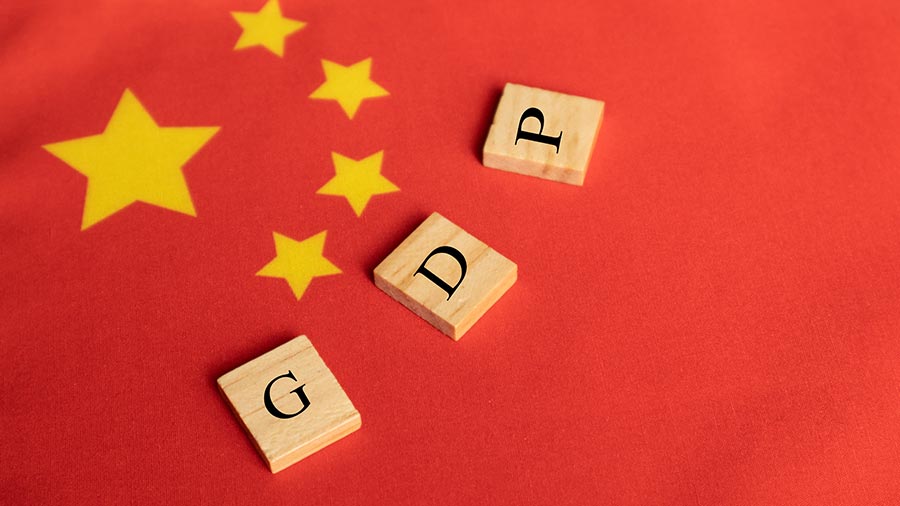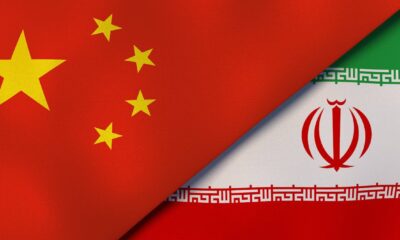China
Is Taiwan a country or not?

The UK referred to Taiwan as an “independent country” in a report, despite not officially recognizing Taiwan as a country.
Defining what is and isn’t a country is a lot more complicated than many people would realize. Take the case of Taiwan.
On Aug. 30, 2023, a committee of the U.K. Parliament referred to Taiwan as an “independent country” in a report. This is the first time any part of the British political system has used that phrasing.
Officially, the U.K. “does not recognise Taiwan” as a country, nor does it “maintain formal diplomatic relations with the island,” which is one way states recognize each other as equals on the international stage.
Like the U.K., the U.S. also “does not have diplomatic relations with Taiwan,” although there is a “robust unofficial relationship,” according to the State Department. Many other countries are in a similar boat.
So where does that leave Taiwan? Is it, or is it not, a country?
From my perspective as a political scientist, here’s how I would approach this question.
A country by declaration
According to what’s known as the “declarative theory of statehood,” a country – which is often referred to as a “state” in political science and international relations terminology – must possess the following qualities: “(a) a permanent population; (b) a defined territory; (c) government; and (d) capacity to enter into relations with the other states.”
These four qualities were agreed upon in the 1933 Montevideo Convention on the Rights and Duties of States, which is an international treaty registered with the League of Nations, the precursor to the United Nations.
Article 3 of that treaty says that the existence of a “state is independent of recognition by the other states.” In other words, as long as the four qualities above are met, an area qualifies as a country even if other countries choose not to recognize it.
One criticism of this framework is that it opens the door for many areas to be considered countries, even though they may seem outlandish.
For example, in the 1960s, Italian engineer Giorgio Rosa built a 4,000-square-foot (400-square-meter) platform 7 miles (11 kilometers) off the coast of Italy. On June 24, 1968, Rosa – whose last name means “rose” in English – declared that his platform was an independent country named the Republic of Rose Island. This artificial island had a restaurant, bar, souvenir shop and post office. Its official language was Esperanto.
It could be argued that Rose Island met the criteria outlined in the Montevideo Convention, as there was a permanent population because Rosa lived there; his humanmade platform had a defined territory; there was a government because Rosa declared himself president; and Rose Island’s post office gave it the capacity to communicate with, and thus enter into relations with, other countries.
Although several countries, including the U.S., have ratified the Montevideo Convention, Italy has not. So, 55 days after Rose Island declared independence, the Italian military destroyed the platform.
A country by recognition
In contrast to the declarative theory of statehood, what’s called the “constitutive theory of statehood” considers a country to be a country only if it is recognized by other already recognized countries.
There is no magic number for how many countries one must be recognized by. Rather, those that aspire to be regarded by the world as an independent country must join the United Nations as a full member.
In order to join the United Nations, applicants must be recommended by the Security Council, which comprises 15 members. Five of those members are permanent and have a veto. Applicants must have the support of nine of the 15 members, including each of the permanent members.
If the Security Council recommends admission, the application is presented to the General Assembly, where each full member of the United Nations has a single vote. A two-thirds majority is necessary before a country can join.
U.S. Rep. Rob Wittman, vice chairman of the House Armed Services Committee, met with Taiwan’s President Tsai Ing-wen, right, at the presidential office in Taipei, Taiwan, in September 2023.
Taiwan Presidential Office via AP
One China or two?
Today, most of the world’s countries officially adhere to some variation of the idea that there is only one China, whose capital is Beijing, and which encompasses both the mainland territory and the island of Taiwan.
There is a government there, but there is also a government on Taiwan, based in its capital, Taipei. That government calls itself the Republic of China and traces its history to the early 20th century, when a revolution overthrew the emperor of China.
Notably, at that time, nobody’s definition of China included the island of Taiwan, which was then commonly called Formosa. Japan had seized the island in a war in the late 19th century.
In 1927, an uprising by the Chinese Communist Party attacked the Republic of China government. That kicked off a bloody civil war that lasted until 1949.
In that year, the government of the Republic of China retreated to the island of Taiwan. That same year, Mao Zedong, leader of the Chinese Communist Party, proclaimed the founding of the People’s Republic of China, with its capital in Beijing.
But Mao still sought control over his enemy’s territory, declaring, “Taiwan is ours, and we will never compromise on this issue, which is an issue of internal affairs.”
To this day, the government of the People’s Republic of China, whose capital is Beijing, considers Taiwan part of its “sacred territory.” The constitution of the People’s Republic of China states that “(i)t is the lofty duty of the entire Chinese people, including our compatriots in Taiwan, to accomplish the great task of reunifying the motherland.” Its foreign affairs ministry says, “Taiwan is a sacred and inseparable part of China’s territory.” On Oct. 2, 2023, the Beijing government celebrated its national day by releasing a video signifying its focus on unity with the people of Taiwan.
In contrast, the Republic of China refers to the area under its control as “the Taiwan area,” or “the free area.” It refers to the rest of China as “the mainland area,” which the Taiwanese government has described as being under a “Period of Communist Rebellion.”
Other countries are similarly delicate. For example, in 1972, the U.S. “acknowledge(d) that all Chinese on either side of the Taiwan Strait maintain there is but one China and that Taiwan is a part of China.” In 1979, the U.S. again “acknowledge(d) the Chinese position that there is but one China and Taiwan is part of China.”
Taipei’s Mid-Autumn Festival drew crowds to the Night Market.
AP Photo/Chiang Ying-ying
Taiwan’s place in the world
Taiwan argues that it meets the Montevideo Convention’s criteria for being considered a country under the declarative theory of statehood. However, Taiwan has not yet formally declared itself to be a new, independent country. According to President Tsai Ing-wen, “(w)e don’t have a need to,” because “(w)e are an independent country already and we call ourselves the Republic of China.”
But recall that, according to the constitutive theory of statehood, a country is only a country if it’s recognized by other already recognized countries, and the ultimate manifestation of such recognition is full membership in the United Nations.
Interestingly, the Republic of China was actually a founding member of the United Nations. However, in 1971, the United Nations voted “to expel” the Republic of China, and instead recognized the Communist government “as the only legitimate representative of China to the United Nations.” Subsequent attempts by Taiwan to join the United Nations have been unsuccessful.
Today, only a dozen or so countries continue to maintain formal diplomatic ties with Taiwan, most of which are small island developing states such as Nauru, Palau and Tuvalu.
Each of these countries recognizes Taiwan as “the Republic of China,” and none of them simultaneously maintains offical ties with the People’s Republic of China.
Until Taiwan formally declares itself independent of the rest of China – or until Taiwan is recognized by the international community as being independent of the rest of China – Taiwan’s status as a country will continue to be questioned.
This article is republished from The Conversation under a Creative Commons license. Read the original article.
Business
China Reports Agreement on Ceasefire between Myanmar’s Factions

Myanmar’s conflicting parties have reached a ceasefire agreement, facilitated by China, aiming to reduce violence and promote peace in the region.
Myanmar Ceasefire Agreement
In a significant development, conflicting parties in Myanmar have reached an agreement for a ceasefire, with China facilitating discussions. This breakthrough is crucial for restoring peace in a nation that has been marred by violence and political strife in recent years. The ceasefire aims to pave the way for reconciliation efforts and improve the humanitarian situation in affected areas.
Role of China
China’s involvement as a mediator highlights its growing influence in resolving regional conflicts. The Chinese government has been working closely with both sides to promote dialogue and trust, crucial elements for a long-term peace solution. Increased stability in Myanmar can benefit regional security and economic development, making China’s mediation significant.
Looking Forward
The hope is that this ceasefire will lead to further negotiations addressing underlying issues in Myanmar. While challenges remain, both parties have expressed willingness to work towards a peaceful resolution. The international community will be watching closely to see if this ceasefire can be sustained and lead to enduring peace for the people of Myanmar.
China
2024 China Economic Review: GDP, Trade, and Foreign Direct Investment Analysis

In 2024, China’s economy grew 5%, supported by stimulus measures, strong exports, and high-tech investments, despite weak domestic demand and demographic challenges. Key sectors like manufacturing and digital economy thrived, necessitating structural reforms for sustained growth into 2025.
China’s economy grew 5% in 2024, driven by stimulus measures, strong exports, and high-tech investment, despite challenges like weak domestic demand and demographic pressures. Structural reforms and targeted policies are essential for sustaining growth into 2025.
China’s economic performance in 2024 saw a return to steady growth, achieving a 5 percent GDP expansion in line with the government’s target, as per the official data released by the National Bureau of Statistics (NBS) on January 17, 2025. This outcome was largely bolstered by stimulus measures that helped drive a stronger-than-expected fourth-quarter recovery. While the country’s economy faced challenges such as declining population numbers and sluggish consumer demand, there were signs of optimism across key sectors, including industrial output and digital economy growth.
Additionally, China is beginning to pivot away from its dependence on the property sector, with the digital economy playing an increasingly significant role in economic expansion.
This article explores the major economic highlights from 2024 and examines the key trends, challenges, and opportunities that will shape China’s economy in the year ahead.
In 2024, China’s GDP reached RMB 134.91 trillion (US$18.80 trillion), maintaining its position as the second-largest economy in the world, behind only the United States, whose projected GDP for 2024 stands at approximately US$29 trillion. This reflects a year-on-year growth of 5.0 percent, in line with the government’s official target of “around 5 percent“ set during the 2024 Two Sessions. While slower than the 5.2 percent growth achieved in 2023, it highlights a stable recovery largely driven by strong export performance and targeted stimulus measures throughout the year.
The economy saw accelerated growth in the final quarter of 2024, with GDP expanding by 5.4 percent, surpassing expectations and making a substantial contribution to the overall 5.0 percent increase. Indeed, quarterly growth performance in 2024 showed steady improvement: the first quarter recorded a 5.3 percent increase, followed by 4.7 percent in Q2, and 4.6 percent in Q3.
Sectoral performance highlights revealed the manufacturing and service sectors as key drivers.
| This article was first published by China Briefing , which is produced by Dezan Shira & Associates. The firm assists foreign investors throughout Asia from offices across the world, including in in China, Hong Kong, Vietnam, Singapore, and India . Readers may write to info@dezshira.com for more support. |
Read the rest of the original article.
China
How China’s appetite for salmon could reshape global seafood markets – new research

China’s salmon demand surged 46% in 2023, prompting global exporters to respond. Challenges in domestic salmon production highlight opportunities for rainbow trout, reshaping the seafood market towards sustainability and consumer preferences.
China’s demand for farmed salmon is growing at an unprecedented pace. In 2023, its imports grew by 46% year on year – with imports of fresh and chilled Atlantic salmon up 63%.
This remarkable growth is reshaping the global seafood trade. Exporters from Scotland, Norway, Chile, Australia, Faroe Islands, Canada and Iceland are racing to supply the needs of this vast and rapidly evolving market.
At the same time, China’s efforts to produce its own Atlantic salmon have faced significant challenges, highlighting the need for substitutes like rainbow trout to meet the country’s growing appetite for seafood delicacies.
An important shift occurred in 2018, when the Chinese government permitted rainbow trout to be labelled and sold as salmon. This decision blurred the distinction between imported Atlantic salmon and locally farmed rainbow trout, creating a more accessible option for cost-sensitive consumers.
Trout is comparable to salmon in appearance and size, with firm and oily meat that has a similar orange-pink colour. Nutritionally too, the species are alike, as are the ways in which they can be cooked and prepared.
In our new research which included taste tests, we found that many Chinese consumers could not distinguish between domestic rainbow trout and imported Atlantic salmon in blind testing. But when informed about the origin, testers’ preferences shifted strongly in favour of imported Atlantic salmon, highlighting the power of provenance in consumer tastes.
Although people’s willingness to pay did not vary initially in our blind tests, it became a decisive factor once the origin of the fish was revealed.
But we found that origin alone was not enough. For our testers to be prepared to pay higher prices, they also had to like the look, smell and taste of the product more, or be persuaded by its ecolabel (indicating environmental standards).
Environmental costs
Transporting Atlantic salmon from Scottish lochs, Norwegian fjords or Chilean waters to Chinese markets involves complex logistics and significant environmental costs. The carbon footprint of this trade, combined with the resource-intensive nature of salmon aquaculture, raises critical concerns about sustainability.
These challenges are particularly pronounced in China, where consumers have a strong preference for freshness. This drives demand for quick delivery of imported salmon despite its environmental impact, and consumers are increasingly turning to online platforms to buy their seafood.
E-commerce has reshaped seafood retail in China, offering quick delivery and products that cater to consumer demand for quality and freshness. Salmon stands out in this market due to its perceived high value, premium quality and price point. Unlike other expensive seafood that often needs to be sold live to maintain its value, salmon retains its appeal when chilled or frozen.
This makes salmon particularly suited to modern retail models, where sophisticated cold-chain logistics ensure its freshness without the complexities of live transport. However, these innovations come at a cost.
The energy-intensive storage and rapid transportation required for imported salmon contribute significantly to environmental harm. As China’s seafood market continues to grow, addressing the sustainability challenges associated with this trade will be critical to balancing consumer demand with environmental responsibility. Current international certification schemes aiming to improve the sector’s sustainability have had limited impact in China so far.
A worker processing imported fresh salmon in a Beijing wholesale seafood market.
David Little, Author provided
China has made significant efforts to establish a domestic Atlantic salmon industry, but these attempts have largely been unsuccessful due to technical challenges and environmental constraints. This has left a gap that domestically farmed rainbow trout is poised to fill.
A trout farming raceway in Chengdu, China, supplied with fresh river water.
Zixuan Ma, Author provided
In 2022, China produced 37,000 tonnes of rainbow trout. This is a relatively small amount compared with international production levels, but still notable considering that rainbow trout is a new farmed species in China, unlike traditional species like carp.
However, rainbow trout farming in China is geographically constrained, as the species thrives in cooler freshwater temperatures found in higher-lying lakes and reservoirs, as well as in “raceways” (channels supplied continuously with fresh water diverted from rivers).
Advances in aquaculture systems offer a potential pathway to expand China’s production. Trout farming is a more sustainable, locally sourced alternative to Atlantic salmon that reduces the carbon footprint associated with imports and ensures fresher options for Chinese consumers. Developing a robust domestic trout industry could enhance food security, reduce dependence on imports, and create economic opportunities in rural areas.
China’s evolving seafood market offers valuable lessons for the global industry. Emphasising quality, freshness and sustainability will resonate with the increasingly sophisticated Chinese consumer.
At the same time, investment in eco-friendly aquaculture practices, both domestically and internationally, will be essential to balance the growing demand for premium seafood with environmental responsibility. These could include reducing feed waste and recirculating aquaculture systems (which filter and reuse water) to minimise water use. Recycling waste nutrients by using them elsewhere in food production could also be key.
As rainbow trout gains prominence in China’s seafood landscape, the relationship between consumer preferences, environmental concerns and economic opportunities could in turn shape the future of the global salmon trade.
If domestic fish captures a larger share of the Chinese market, salmon producers in Europe, Canada and other exporting regions may face significant challenges. This could ultimately force them to rethink their strategies in order to adapt to shifting market dynamics.
Although the goal of creating a domestic Atlantic salmon industry has proved difficult for China, trout farming presents a practical and sustainable solution for its luxury seafood sector.
This article is republished from The Conversation under a Creative Commons license. Read the original article.











